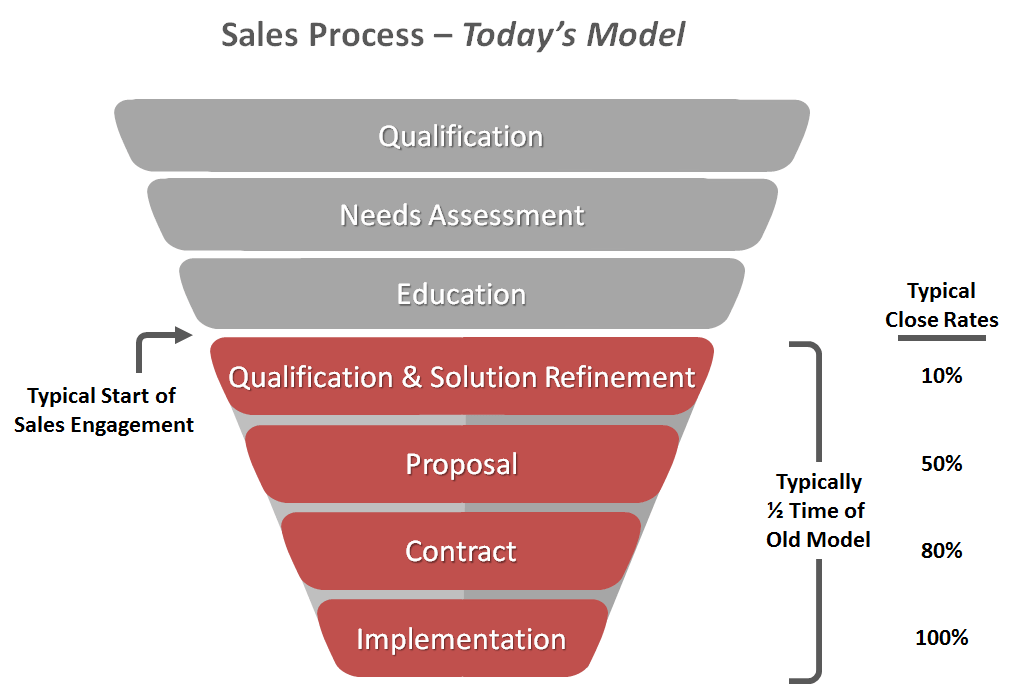It seems at least once a week that I talk to a B2B company about how to shrink their sales cycle. Sales executives and CEOs get especially frustrated because their quarterly sales forecasts become much harder to predict when the sales cycle timing is all over the map. For example, we have one technology client where it seems half their deals close in days or weeks, while the other half can take six months or more. So what is going on and what can us B2B marketing types do about it?
The first thing we need to do is accept certain realities, regardless of the pain involved. And the first reality is that buyers have more control over the sales cycle than sellers. They have come to understand that the offer you claimed was for today only can easily be had tomorrow or next month – especially if they wait to buy until the end of the quarter. And even more significantly, our prospects know they can use Google to find out a great deal of information about your company, your competitors, the product or service category, and what past buyers think about you and everyone else in your space.
Here is the relevant point about the new realities: the important thing is not the actual sales cycle (how long it takes the prospect from the time they start their research to the time they buy). Rather, the key metric is what we refer to as the “effective sales cycle” – how long the prospect is actually in touch with your company.
If you organize your business around the new type of selling model as shown below, the “effective sales model” will shrink and your close rate will go up. This is true because the potential purchaser completes all or most of the first three parts of the process without engaging with your sales staff. In this example, if you start interacting with prospects at the fourth stage, close rates can skyrocket – from a typical 1-3 percent of raw inquiries to as much as 10 percent of those who are educated and self-qualified.
So how do you create the environment to support everyone from early-stage information gatherers to hot prospects who are ready to engage or buy today? Here are a few tips:

- Provide content relevant to the needs of the audience. This will be very different for someone who is doing some general category research (what’s out there) as opposed to someone who is in the final buying stage (pricing, terms and delivery options).
- Layer the content. At Fusion Marketing Partners, we recommend the layered content approach. Of course this varies by type of product and offer, but we typically recommend fairly short and generalized text on the landing page (e.g. 300-500 words). On pages that link from the landing page, text can be much longer, running into hundreds or even thousands of words for some technical products and services.
- Offer options. Don’t treat all visitors to your website like they’re the same. Some are at early stages: give them a place to browse content and self-educate without a sales person breathing down their necks. Others are at later stages: give these people a way to self-qualify and engage in different ways – phone, chat, email, form submission.
- Enable self-service. Sales resources are expensive and whatever parts of the processes you can offload to the website will cut your costs, and assuming you execute this correctly, boost your effectiveness. As reported in a recent Forbes article titled Death of a B2B Salesman, a Forrester Research study showed that “Nearly 75% of B2B buyers now say that buying from a website is more convenient than buying from a sales representative. Further, 93% say that they prefer buying onlinerather than from a salesperson when they’ve decided what to buy. B2B companies that wait too long to create self-serve eCommerce websites risk losing share to pure plays and omnichannel competitors.”
As you can see, marketing can help shrink the effective B2B sales cycle, but it may require a new of thinking – as well as some concrete actions to align your selling model with your prospects’ buying behavior.
This article was syndicated from Business 2 Community: Can You Really Use Marketing to Shrink the B2B Sales Cycle?
More Sales & Marketing articles from Business 2 Community:




